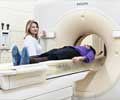It is cost-effective to do CT scan screening of non-smoking women, ages 25-54, who come to the emergency room for the first time with a collapsed lung in order to diagnose and treat those with lymphangioleiomyomatosis, or LAM, researchers at the University of Cincinnati (UC) have found.
This data is being featured in the online edition of the American Journal of Respiratory and Critical Care Medicine.LAM is a rare but serious lung disease that occurs when an unusual type of cell begins to grow out of control and spread to restricted areas in the body, including the lungs, kidneys, lymph nodes and vessels.
"Women with LAM who first experience spontaneous lung collapse will, on average, experience two more," says Brent Kinder, MD, an investigator in the study. "LAM diagnosis doesn't usually occur until the second or third collapse occurs, delaying treatment. We thought that targeting screening to non-smoking women in the age range of typical LAM development may help us identify the condition earlier and improve quality of life for these patients."
Kinder and Jared Hagaman, MD, along with colleagues in the department of medicine, developed a model to evaluate the cost-effectiveness of screening patients for LAM. Using national representative data sources, researchers looked at rates of collapsed lung and prevalence of LAM in relation to age, gender and smoking status.
They compared the benefit and cost of using high-resolution CT screening following lung collapse for patients with LAM to no CT screening. Costs of testing and treatment were taken from 2007 Medicare data.
Based on the model patient who comes into the emergency room with a spontaneous lung collapse—a 30-year-old, non-smoking female—about 5 percent test positive for LAM.
Advertisement
"This data will help physicians intervene with therapies more quickly and enroll patients in clinical trials that may be able to slow progression of the disease."
Advertisement
Source-Eurekalert
RAS









